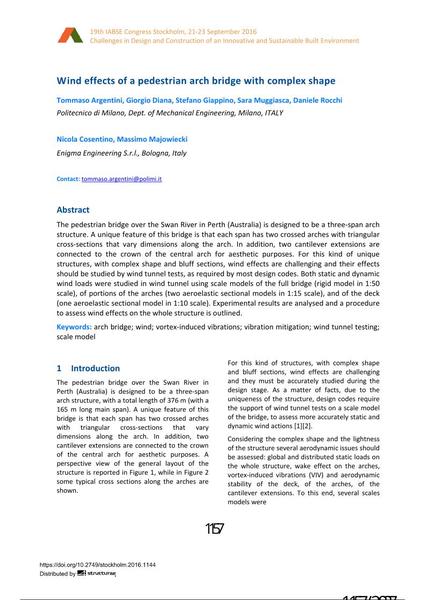Wind effects of a pedestrian arch bridge with complex shape

|
|
|||||||||||
Bibliographic Details
| Author(s): |
Tommaso Argentini
Giorgio Diana Stefano Giappino Sara Muggiasca Daniele Rocchi (Politecnico di Milano, Dept. of Mechanical Engineering, Milano, ITALY) Nicola Cosentino (Enigma Engineering S.r.l., Bologna, Italy) Massimo Majowiecki (Enigma Engineering S.r.l., Bologna, Italy) |
||||
|---|---|---|---|---|---|
| Medium: | conference paper | ||||
| Language(s): | English | ||||
| Conference: | IABSE Congress: Challenges in Design and Construction of an Innovative and Sustainable Built Environment, Stockholm, Sweden, 21-23 September 2016 | ||||
| Published in: | IABSE Congress Stockholm, 2016 | ||||
|
|||||
| Page(s): | 1157-1164 | ||||
| Total no. of pages: | 8 | ||||
| Year: | 2016 | ||||
| DOI: | 10.2749/stockholm.2016.1144 | ||||
| Abstract: |
The pedestrian bridge over the Swan River in Perth (Australia) is designed to be a three-span arch structure. A unique feature of this bridge is that each span has two crossed arches with triangular cross-sections that vary dimensions along the arch. In addition, two cantilever extensions are connected to the crown of the central arch for aesthetic purposes. For this kind of unique structures, with complex shape and bluff sections, wind effects are challenging and their effects should be studied by wind tunnel tests, as required by most design codes. Both static and dynamic wind loads were studied in wind tunnel using scale models of the full bridge (rigid model in 1:50 scale), of portions of the arches (two aeroelastic sectional models in 1:15 scale), and of the deck (one aeroelastic sectional model in 1:10 scale). Experimental results are analysed and a procedure to assess wind effects on the whole structure is outlined. |
||||
| Keywords: |
wind arch bridge vortex-induced vibrations vibration mitigation wind tunnel testing scale model
|
||||
